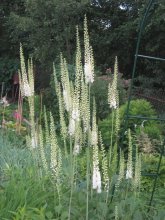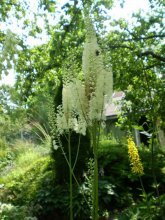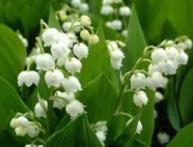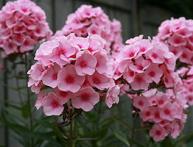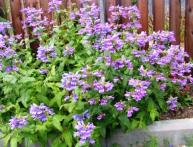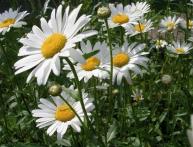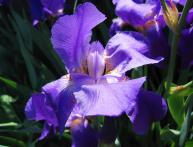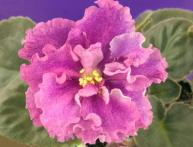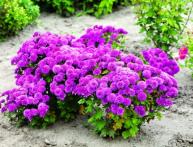Black cohosh plant in the garden, description, cultivation, benefits

There are plants whose names immediately inform about its main characteristics. Translated into Russian, the word cohosh sounds like a bug and I drive away or black cohosh. It immediately becomes clear that the plant was used to expel bedbugs.
If the gardener does not like this completely unromantic name, he can use another name, which translated from German sounds like silver candles. Let's try to figure out what it is, black cohosh, and why it is needed in the garden.
Content:
- Cosimifuga racemosus, botanical description of the plant
- How to grow black cohosh in the garden
- Use of the black cohosh plant in medicine
Cosimifuga racemosus, botanical description of the plant
The black cohosh plant is a species of perennial herbaceous plant from the Voronets genus of the Ranunculaceae family. The homeland of wild cohosh is the deciduous forests of North America. In the eastern part of the continent, the plant is distributed in the states:
- Arkansas
- Georgia
- Wisconsin
- Alabama
Wild growing black cohosh prefer to grow on the slopes of ravines, along streams, edges, among other tall grasses and shrubs. It is important for her that the soil is moist and rich in humus. In the 18th century, the plant began to be widely cultivated on the Eurasian continent.It is noteworthy that the plant was described and classified by several botanists - taxonomists.
Only in the 20th century was the question of his belonging to the Voronets family resolved, and the name Racemosus Voronets returned to him. This is exactly what Carl Linnaeus named the plant in the mid-18th century. Other species of crow are found in nature in Europe and Asia. The plant has fairly tall stems. It can reach 1.5 - 2 meters in height. The stem is straight and smooth. The cut is rectangular.
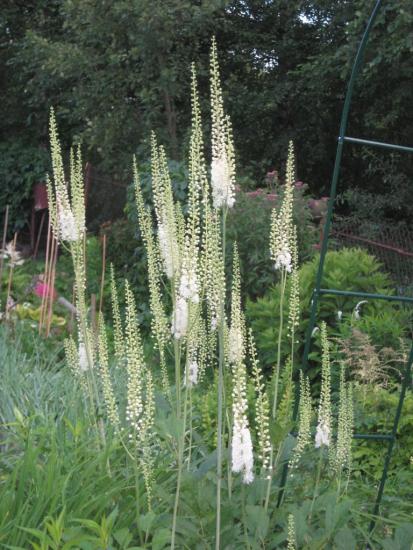
The leaves are smooth, twice or thrice dissected, green in color with a shiny surface. The length of the leaf blades can be up to 12 cm. The number of leaves on one stem can sometimes reach up to 70 pieces. The flowers are white, collected in a raceme inflorescence, the height of which can be from 0.2 m to 1.0 meter. The ends of the inflorescences droop downwards. The four petals of the bract fall off very quickly.
After this, the yellowish stamens are exposed and the flowers, with their sweet but not very pleasant smell, attract flies and other insects that like the sweetish, cloying smell of decaying flesh. The petals of the flowers are small, only 3 mm.
In place of the flowers, leaflet fruits are formed, each of which contains about two dozen seeds. The powerful rhizomes and roots of the plant deserve special attention. Due to the winding branching of the roots, the plant received another popular name: snake root or black snake root. In the garden, black cohosh has two purposes, one of which is medicinal, and the second is decorative.
How to grow black cohosh in the garden
For decorative purposes, black cohosh is planted when landscaping fairly dark and damp corners of the site.The plant looks good next to ferns, low conifers, and astilbe. They can also be planted in large, homogeneous groups.
Selecting a location
The best place for planting black cohosh will be a slightly shady place with moist, fertile soil, protected from strong winds and drafts. Despite the plant’s love for water, it is important to ensure that there is no stagnation of rain and melt water on the site in spring and autumn. In such conditions roots plants may rot and die completely. Before planting, the area is dug deeply and organic and mineral fertilizers are applied.
Reproduction and planting
The plant reproduces vegetatively and by seeds. In amateur floriculture, it is best to propagate black cohosh by dividing the bush. For propagation by dividing the bush in spring or autumn, an adult plant older than five years is dug out of the ground. Using a sharp knife, divide the rhizome into three to four parts. Holes are prepared for the divisions at a distance of about half a meter. A part of the root is placed in each hole and covered with soil. The planting site is watered with water. Black cohosh roots can also be purchased in specialty stores.
If the purchase is made before the onset of summer, then they can be planted in pots, and when warm weather arrives, transplanted into open ground. When sowing seeds, two methods can be used. In the first case, sowing is done in the fall with freshly collected seeds.
However, under unfavorable conditions, black cohosh seeds may rot during the autumn-winter period. Therefore, some of the seeds are first stored in a dry place, and then complex stratification is carried out. Why are seeds sown and pots containing them kept in warm and cold conditions?
Stratification begins in January. The seeds are kept at + 20 for three months, and then for another three months at + 5 degrees.If the experiment results in successful germination seeds, then such plants will bloom only after three to four years. In general, this plant is a long-liver. It can grow in one place for up to two decades.
Caring for an adult plant is not particularly difficult. In summer, black cohosh needs additional abundant watering in the absence of precipitation. If it was planted in a fairly dry place, then watering should be more frequent and abundant. Especially tall specimens need a garter. In autumn, the ground parts are cut off close to the ground, and the planting site is mulched and covered with spruce branches.
Since ancient times, American Indians have known about the medicinal properties of black cohosh.
Use of the black cohosh plant in medicine
In folk and official medicine, roots and rhizomes plants. They contain the following beneficial substances:
- phytoestrogens
- phytosterols
- bitterness
- glycosides
- saponins
- starch
- tannins
- resins
- organic acids
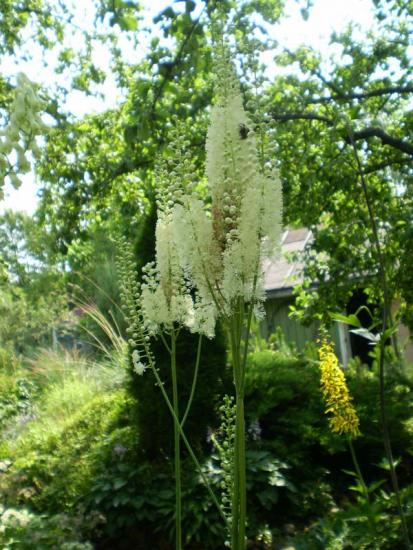
The presence of estrogen-like compounds in the roots and rhizomes of the plant allows them to be used primarily in gynecology. Decoctions of roots and rhizomes soften menstrual pain and help with various gynecological problems, even such serious ones as infertility and endometritis.
It is recommended to use black cohosh after childbirth to alleviate postpartum pain and to stimulate the production of breast milk. The pharmaceutical industry includes rhizomes in preparations that alleviate menopause. They drink decoctions to relieve swelling and as a sedative.
The procurement of raw materials is carried out in the autumn. Roots and rhizomes are dug up, after that:
- clear of excess soil
- washed under the tap
- dried at temperature + 60
- put in paper bags
- store for two years in a dry place
Like any medicine, decoctions from the roots and rhizomes of black cohosh have contraindications for use. They should not be used by people with a diseased liver during an exacerbation. diseases, as well as those suffering from neoplasms, which can accelerate their growth when consuming hormone-like substances.
Video about the cohosh plant:

